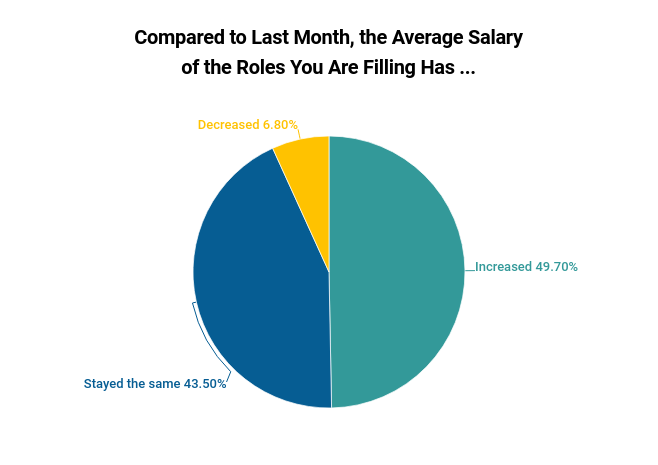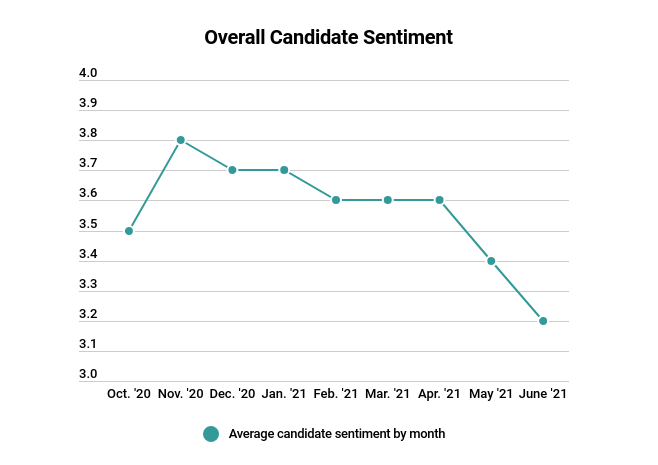The Great Resignation: What It Is, Why It’s Happening, and What Employers Can Do to Come Out on Top

Almost as soon as the pandemic hit, recruiters and employers began planning for the Great Rehire, the hiring spree companies would need to staff back up once the threat of COVID had faded.
But as vaccination rates rise and case counts fall, we find ourselves facing a whole different beast: the Great Resignation.
Instead of hiring huge numbers of candidates, companies are watching employees leave in droves. A record 4 million people quit their jobs in April — the highest rate of single-month resignations in 20 years; many more are planning to leave soon. While unemployment remains well above its pre-pandemic levels, employers are struggling to fill their open roles.
How can organizations stop hemorrhaging talent and start building their workforces for a post-pandemic economy? First, you need to understand why the Great Resignation is happening. Then, you need to build a proactive recruitment strategy that broadens your reach with robust talent pipelines and agile teams of on-demand recruiters.
Why Your Employees Are Leaving
Anthony Klotz, an associate professor of management at Texas A&M University, is widely credited as the first to predict the Great Resignation, telling Bloomberg Businessweek this past May that two factors were poised to drive mass resignations among American workers. First, the uncertainty of the pandemic forced many employees who were already planning to quit to pause their resignations. As the job market recovers, these workers will regain their confidence and start resigning en masse. Second, the pandemic gave many people an opportunity to reevaluate what matters to them, and for some, their day jobs didn’t make the cut.
A third factor could be at work, too. According to recent research from FlexJobs, roughly half of job seekers say they can’t find open opportunities that fit their skills and preferences. Traditionally, this dynamic has been to blame for many of the talent shortages we’ve seen in the past. Combined with the factors Klotz outlined, it could be a recipe for disaster.
That’s how we’ve ended up where we are right now, with Monster reporting that 95 percent of employees are considering quitting as job market prospects improve.
Complicating matters further, these quits are coming at a time when unemployment is up and talent shortages have hit a 15-year high. How do we explain this strange confluence of events: high unemployment, a lot of resignations, and a paradoxically low supply of talent?
To answer that question, we have to understand why employees are leaving:
1. Burnout
According to Monster’s research, burnout is the single most common reason why employees are thinking of quitting. While the pandemic may have shut down the outside world, it actually amplified the pace of work. In fact, the average workday expanded by 48 minutes during the pandemic. Many workers simply feel they can’t keep going at this rate, and they’re quitting for their health.
2. Changing Values
As the combination of a high unemployment rate and a talent shortage makes clear, many employees are quitting without lining up a new job first. Some don’t even intend to look for work at all — at least, not yet.
In what has been termed the “YOLO economy,” many workers are ditching their day jobs for passion projects, side hustles, and sabbaticals. After a year of lockdown, these workers have emerged with new priorities, and their jobs are not at the top of their lists. The YOLO attitude isn’t limited to American workers, either. It’s a global problem, with a recent survey of British workers finding that the number of millennials planning to start their own businesses increased threefold due to the pandemic.
Another portion of the workforce, forced out of their jobs by the pandemic, is hesitating to return to the office for different reasons. Millions of working parents, especially working mothers, have left their careers in the last year to focus on caregiving. Surveys show the majority of them don’t intend to return to work for the time being. For many of these parents, the eternal work/life balance struggle simply isn’t worth it any longer.
3. The Decline of Remote Work
Employees and employers are divided on the question of remote work. Despite high-profile tech companies like Twitter and Facebook embracing permanent remote work, most employers seem set on returning to the office.
In the Recruiter Index®, Recruiter.com’s monthly survey of recruiters and HR pros, respondents have reported a steady decline in the number of remote roles available over the past two months. Remote work hit an all-time low in June, with only 17 percent of recruiters reporting most of their open roles were remote roles. At the same time, remote work has routinely ranked as candidates’ top priority, aside from compensation, in the Recruiter Index.

In the June 2021 Recruiter Index®, 83 percent of recruiters said the majority of their open roles required at least some in-person work.
Organizations can insist that employees return to the office — but many workers are simply quitting instead. In fact, 40 percent of workers say they’ll leave if their bosses demand they return to the office.
4. Holding Out for Better Offers
Finally, some workers are playing the long game. For two months in a row, the Recruiter Index® has found that an increasing number of employers are raising the average salaries for their open roles in an effort to attract talent. Savvy job seekers are aware of this, and some are trying to wait out the market. Why take a job now when the salary could go up even further next month?

In the June 2021 Recruiter Index®, 50 percent of recruiters said average salaries had increased since May.
How to Come Out on Top of the Great Resignation
The truth is that no organization will emerge from the Great Resignation entirely unscathed. The factors driving this sea change aren’t all within your company’s control, but there are certain steps you can take to minimize the damage and set yourself up to outperform your competitors in this difficult job market.
The first step is to double down on retention efforts in a bid to keep as many employees on board as possible. You won’t convince everyone to stay, but you can give them fewer reasons to quit.
• Can you offer programs and perks to reduce burnout?
• Can you put supports in place so that working parents can remain with your company?
• Could you be flexible on remote work?
By tackling as many of the factors behind the resignation as you can, you’ll mitigate your losses.
But losses will occur — and moreover, your company will continue to grow in the post-pandemic economy. You’ll need to both backfill existing roles and source talent for brand-new jobs. So, in addition to doubling down on retention, you’ll need to ramp up your hiring process to handle the increasing number of roles you need to fill.
Proactivity is key for two reasons. First, some of your employees’ resignations will take you by surprise, and you don’t want to be caught unprepared and scrambling for candidates. Second, qualified candidates looking for new jobs are few and far between in this market. According to the Recruiter Index®, candidates have been steadily losing interest in new opportunities since November 2020. You want to start looking for talent now because it might not be there when you need it.

Candidate sentiment is scored on a scale of 1-5, with 1 being “Candidates are not interested in open roles at all” and 5 being “Candidates are extremely interested in open roles.”
What you need is a robust candidate pipeline that consistently delivers vetted candidates to your door. Thanks to advances in AI-powered job-matching technology, that pipeline isn’t hard to build. Recruiter.com’s talent sourcing tools scour the internet for skilled professionals, using artificial intelligence to match candidates’ qualifications with your open roles. These tools essentially create self-sustaining pipelines, so you always have a talent pool to tap when you need it.
But finding talent is only one part of the equation. When it comes to ramping up your hiring process, you also need a recruiting team capable of handling the increased volume of hiring activity. If you don’t have enough recruiters in place, you may feel you’re in a bind: It’s hard enough to recruit candidates, let alone recruiting people to recruit those candidates. And demand for recruiting talent is surging, becoming the second-most hotly sought-after type of talent in June, according to the Recruiter Index®. The war for talent is alive and well in recruiting and staffing circles.
On-demand recruiting is a useful alternative to recruiting more recruiters, allowing you to power up your talent acquisition team without increasing headcount. With Recruiters On Demand, employers can build virtual teams of recruiters who specialize in the particular roles they need to fill. You can bring on as many recruiters as you need for as long as you need them, and you define the scope of their work. You’ll have all the recruiting help you need, and you can focus on hiring mission-critical talent instead of recruiting more recruiters.
The challenges of the pandemic aren’t over yet, and the Great Resignation may turn out to be the most troubling COVID-created obstacle of all. But employers can come out on top as long as they keep a few things in mind:
• Invest in retention
• Build proactive talent pipelines
• Get the recruiting help you need
To learn more about how Recruiter.com can help you recruit talent faster with virtual teams of Recruiters On Demand and video and AI job-matching technology, click here.
Get the top recruiting news and insights delivered to your inbox every week. Sign up for the Recruiter Today newsletter.

